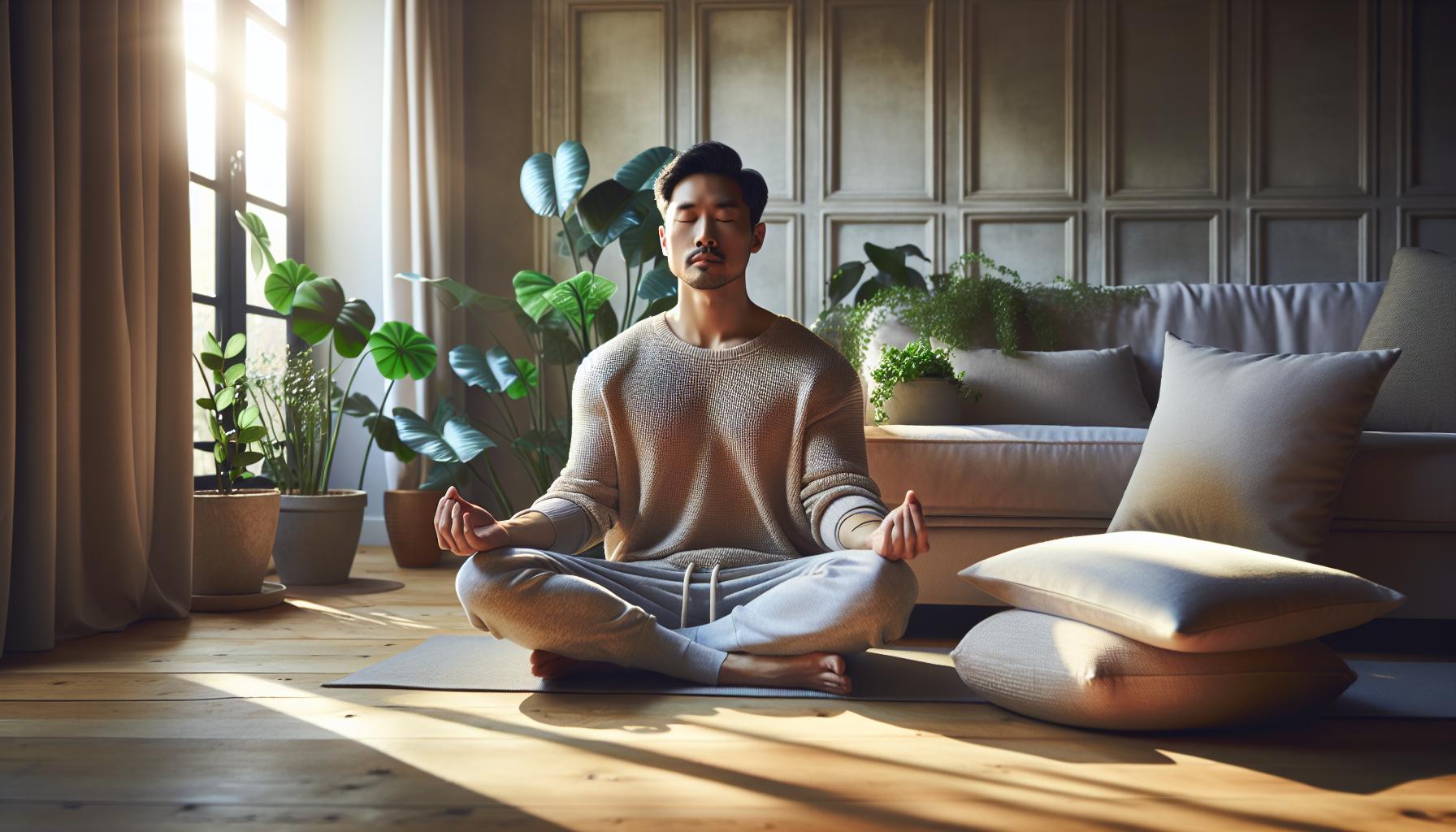How to Use Guided Meditation for Effective Stress and Anxiety Relief
Imagine settling into your coziest chair, the kind that hugs you back, with a warm cup of tea by your side. Today, I’m diving into the gentle world of guided meditation, a practice that’s as soothing as our morning chats across the kitchen table. I’ve always been curious about how these simple, guided thoughts can melt away the stress and anxiety that often buzz around us like unwelcome flies.
As I explored this topic, I found that guided meditation isn’t just about finding a quiet moment; it’s about creating a sanctuary in your mind, no matter where you are or what’s happening around you. It’s like discovering a secret garden where each breath in is a new bloom and each breath out a whisper of peace. Join me as we step through the gate and learn how to weave this peaceful practice into our daily lives, promising not just relief but a splash of joy in our everyday routines.
The Benefits of Guided Meditation for Stress and Anxiety Relief
Guided meditation isn’t just a trendy buzzword. Trust me, it’s like having a superpower in your back pocket that you can whip out when stress and anxiety come knocking. Let’s dive into the specifics and see how this magical tool works to melt away your worries.
Immediate Relief from Stress
Feel the weight of the world on your shoulders? Guided meditation offers immediate relief. By focusing on calming guidance, your brain switches gears from stress to relaxation. It’s like pressing a giant mental pause button, giving you a break from the chaos of your daily grind. Studies show that even a brief session can reduce cortisol levels, the pesky stress hormone that can wreak havoc on our bodies.
Reduction in Anxiety
Long-term benefits? Oh, you bet. Regular guided meditation can rewire your brain to handle anxiety better. It increases gray matter concentration in areas of the brain involved in emotional regulation and resilience. Essentially, it’s like upgrading your brain’s software to better manage those anxiety bugs.
Improved Sleep Quality
Nothing beats a good night’s sleep, and with guided meditation, you’re setting the stage for just that. By calming the mind before bedtime, you’re more likely to fall asleep faster and enjoy deeper, more restful sleep. Consider it your nighttime brain lullaby.
Enhanced Emotional Health
Guided meditation isn’t just about feeling less stressed. It’s about enhancing your overall emotional health. Engaging regularly in this practice can boost your mood, increase positivity, and even improve relationships. It’s like fertilizing your emotional garden, allowing beautiful feelings to bloom.
So, if you’re tired of letting stress and anxiety rule your life, consider guided meditation your new best friend. It’s a simple, effective tool that you can use anytime, anywhere to regain peace and bring a little more joy into your days. Remember, a few minutes of guided meditation can lead to hours of better mood, heightened productivity, and yes, even a happier you.
Key Components of Effective Guided Meditation

Guided meditation isn’t just about closing your eyes and hoping for the best. It’s an effective strategy, a bit like having a GPS for your mind to navigate through the chaotic traffic of stress and anxiety. Let’s break down the essentials that make this technique really tick.
Understanding Intentions and Goals
Setting your intentions is like planting seeds in a garden. You decide what you want to grow, whether it’s peace, resilience, or perhaps a dash of joy. These intentions act as clear goals and give your mind a focus during meditation.
First, articulate what you’re aiming to achieve with the meditation. It could be managing your stress after work or calming your nerves before a big presentation. Knowing this shapes your meditation session and aligns it with your needs.
Track your progress by mapping out these intentions in a journal or an app. Note improvements, like feeling less overwhelmed over the weeks, which confirms your meditation is on point.
Finally, adapt your goals as you evolve. Initially, you might focus on simply calming your mind, but later, expanding your meditation to enhance creativity or improve sleep might become your aim. The flexibility to shift your goals ensures that your practice grows with you.
The Role of a Guided Voice
The voice leading your guided meditation is kind of like the narrator of your favorite podcast — it needs to click with you. The tone, pace, and even the accent play significant roles in how effectively you can relax and focus. If the voice grates on your ears, your meditation session might turn into a teeth-clenching ordeal rather than a soothing escape.
Choose a voice that feels soothing and trustworthy to you. Some people prefer a soft, gentle tone, while others might find a deep, resonant voice more comforting. It’s a personal choice.
The content of what the voice says is crucial too. It should provide clear directions but also leave space for personal reflection. Remember, the voice isn’t there just to fill the silence; it guides your brain through a process of relaxation, visualization, and sometimes, transformative healing.
In digital formats, you often have the option to select a voice or even a language that suits you best. Use this feature to tailor your meditation experience to your liking, ensuring that it remains a rejuvenating and not an irritating experience.
Selecting the Right Guided Meditation

Choosing the right guided meditation can be as crucial as picking your coffee blend for starting your day right. Let’s dive into how to pick one that’ll soothe your nerves and declutter your mind.
Factors to Consider
When selecting guided meditations, consider a few key factors that influence their effectiveness:
- Voice: The narrator’s voice plays a massive role, much like listening to a soothing podcast. You’ll want a voice that doesn’t make you cringe but instead, feels like a warm blanket on a chilly evening.
- Duration: Life’s busy, I get it! Pick meditations that fit into your schedule. Whether it’s a quick 5-minute recharge or a longer 30-minute session, make sure it matches your daily routine.
- Purpose: Are you looking to chill out or find a burst of morning energy? Maybe you need help falling asleep? Choose a meditation aimed at your specific needs; it’s like choosing a workout for your brain.
- Music and Sounds: Some of us love a bit of background piano or nature sounds, while others might prefer silence. Listen in and see what sounds help you zone in—or out!
Recommended Platforms and Apps
Here’s a rundown of some top platforms and apps that can help you get started with guided meditation. I’ve tried a bunch, and here are my go-tos:
- Headspace: Perfect for beginners and busy bees. Their guided sessions are short, sweet, and super effective. Plus, their app’s design is as calming as their meditations.
- Calm: If nature sounds and sleep stories are your jam, Calm is the way to go. They’ve got sessions that can help soothe you to sleep or just keep your mind from running a marathon.
- Insight Timer: With a gigantic library of free sessions, Insight Timer gives you lots of choices, from beginner to guru-level meditations.
- Simple Habit: Ideal for those who always are on a time crunch. Their five-minute meditations can fit into any schedule.
Tips for Enhancing Your Guided Meditation Experience

Conquering stress and anxiety with guided meditation doesn’t just happen; it’s like perfecting your coffee game—it requires some tweaks and personal touches. Here’s how you can fine-tune your experience and make the most out of each session.
Creating a Conducive Environment
My first tip? Setting up the right space. You wouldn’t binge-watch your favorite show in a noisy café, right? Same goes for meditation. Pick a quiet spot where interruptions are less likely than a celebrity sighting at your local grocery store. Comfort is key – think of creating a nest with cushions, a comfy chair, or even a spot on the grass outside.
Lighting can totally set the mood. Bright lights can be as jarring as a cold shower, so go for softer, dimmer options or candles that don’t just scream romance but also whisper “relax”. Scent plays a big part, too. A diffuser with lavender or sandalwood can transport your senses to peace quicker than you can say “Om”.
And remember, this spot doesn’t have to be fixed. Feel free to change locales like you’re channel-hopping if it helps you find your zen.
Incorporating Physical Relaxation Techniques
Before diving into your guided meditation, don’t just jump in cold turkey—prepare your body. Start with some light stretching. Nothing hardcore, just enough to tell your muscles they don’t need to be on guard duty.
Breathing exercises are gold. Try the 4-7-8 technique: breathe in for four seconds, hold it for seven, and exhale for eight. It’s like a mini massage for your nervous system, calming you down almost instantly. If my brain’s racing like it’s in the Indy 500, I focus on slowing my breath, which helps park those racing thoughts into their pit stop.
Lastly, give progressive muscle relaxation a shot. Tense each muscle group for a few seconds then release. It’s like telling your body, “Hey, ease up. We’re just chilling.” By the time you start your guided session, you’ll feel ready to float into tranquility.
How to Incorporate Guided Meditation into Your Daily Routine

Integrating guided meditation into daily life provides both immediate stress relief and long-term benefits. Here’s how you can make this tool part of your everyday routine.
Easy Start Strategies
Imagine starting your day with a mental massage — that’s what guided meditation offers. To begin, integrate short, five-minute sessions into your daily routine. Mornings usually work best, helping you set a positive tone for the day. Find a spot in your home where you can sit undisturbed—perhaps a cozy corner with a cushion or a comfy chair. Use an app like Headspace or Insight Timer, and select a guided meditation that appeals to you. Focus on your breathing, and allow the guided voice to ease you into a state of relaxation. It’s like having a personal trainer for your mind!
Maintaining Consistency and Motivation
Sticking to a meditation routine can be tricky. I keep my motivation up by setting manageable goals, like meditating every morning for a week, and then rewarding myself when I hit that target. Maybe a new book or a special treat! It’s also helpful to keep a meditation log. Just jot down a few notes about how each session makes you feel. Seeing your progress written down can be incredibly encouraging. Finally, remember the feelings of calm and relaxation that follow your meditation sessions—these are your body’s own reminders of why sticking with meditation is worth it.
Conclusion
Embracing guided meditation as part of your daily routine is like unlocking a personal sanctuary where stress and anxiety can’t reach you. It’s not just about stealing a moment of calm but about transforming your approach to life’s challenges. By finding the right guided meditation that speaks to you, setting a serene environment, and gently incorporating this practice into your day, you’ll begin to notice profound shifts in your mood and overall mental health. I’ve found that even on my busiest days, a few minutes of guided meditation provide a refreshing pause that enhances my clarity and focus. So why not give it a try? It might just be the key to a more peaceful and joyful life. Remember it’s about taking that first step and allowing yourself to experience the benefits unfold in real time.

